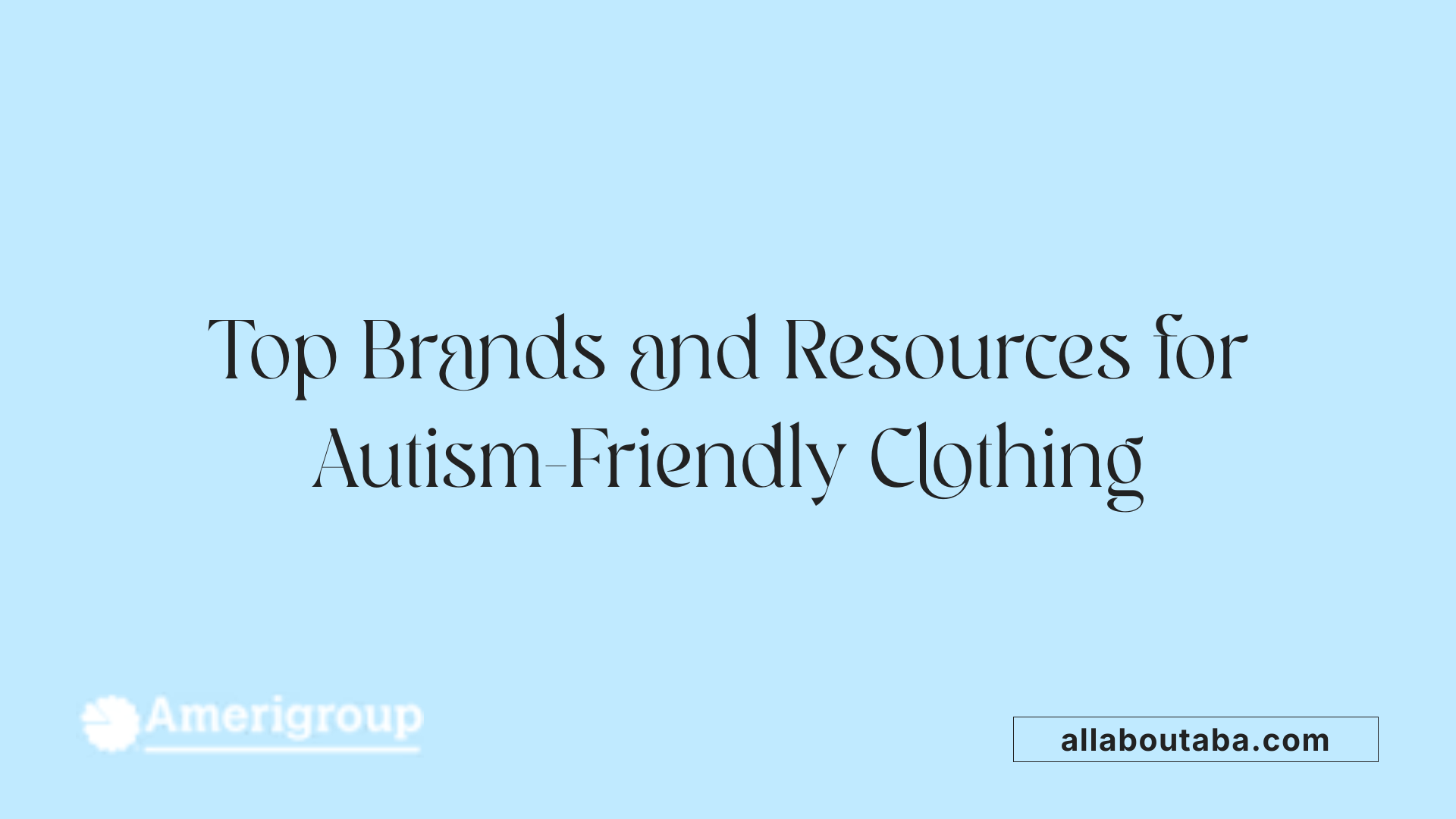Understanding the Importance of Sensory-Friendly Clothing for Autistic Children
Children with autism often experience sensory processing difficulties that make clothing choices challenging. To promote comfort, safety, and independence, specially designed adaptive clothing can make a significant difference. Various brands and resources now offer innovative solutions aimed at reducing sensory discomfort, easing daily routines, and supporting behavioral and emotional regulation.
Types of Suitable Clothing for Children with Autism and Sensory Sensitivities

What types of clothing are suitable for children with autism and sensory sensitivities?
Children with autism and sensory sensitivities often require clothing that prioritizes comfort, safety, and ease of use. The right clothing can significantly improve their daily experience, helping to reduce overstimulation and promote relaxation.
Soft, breathable fabrics are essential. Materials such as 100% cotton, bamboo, and modal are popular choices because they are hypoallergenic, antibacterial, and gentle against sensitive skin. These fabrics minimize irritation and allow for comfortable wear over extended periods.
In addition to fabric choice, the design features of clothing play a crucial role. Sensory-friendly options often include seamless designs, which eliminate annoying seams that can cause discomfort. Tagless labels and fasteners like zippers, snaps, or buttons are also avoided, as they can scratch or irritate sensitive skin.
Furthermore, specialized clothing such as weighted vests, compression shirts, and deep pressure clothing has been shown to help regulate sensory input. These garments provide gentle, calming pressure that can soothe the central nervous system, aiding children in calming down and maintaining focus.
Brands like Kozie Clothes and mainstream retailers such as Target have developed products specifically tailored to these needs. Kozie offers a range of adaptive and sensory-friendly clothing, including compression shirts, vests, bodysuits, and accessories designed to support children with autism in feeling secure and comfortable throughout their daily routines.
Overall, selecting clothing that combines comfort, safety, and functional adaptation can make a marked difference in supporting children with sensory sensitivities, helping them engage more comfortably with their everyday environment.
Design Features That Enhance Comfort and Functionality

What are the features and design considerations for clothing tailored for children with sensory sensitivities?
Clothing designed for children with sensory sensitivities is crafted with the child's comfort and sensory preferences in mind. One of the most important aspects is the choice of materials. Soft, breathable fabrics such as cotton, bamboo, and modal are commonly used because they feel gentle against the skin and allow for airflow, which helps prevent overheating and discomfort.
In addition to fabric selection, construction details matter greatly. Flat seams, tagless labels, and seamless or simplified stitching are standard features. These design elements help minimize tactile irritation and prevent skin from being scratched or irritated by traditional seams or tags.
Adjustability is another critical feature in sensory-friendly clothing. Stretchy closures, zippers, snap buttons, and elastic waistbands allow for a snug yet flexible fit. These adjustable elements not only improve comfort but also enable caregivers to dress children more easily, fostering independence.
Furthermore, some adaptive clothing incorporates features such as deep pressure compression, which can have a calming effect on the nervous system. This might include snug-fitting shirts or vests designed to provide gentle, consistent pressure, helping children regulate their arousal levels.
Overall, the goal in designing sensory-friendly clothing is to create garments that support sensory regulation, facilitate ease of dressing and undressing, and allow full movement. By combining soft fabrics, thoughtful construction, and adjustable features, these clothes promote a sense of security and comfort, which can significantly improve the child's overall well-being and confidence.
Strategies and Techniques for Transitioning Children into Appropriate Clothing

What strategies can help transition children with autism into wearing suitable clothing?
Transitioning children with autism into wearing clothes that meet their sensory and medical needs can be a careful process. Establishing consistent routines plays a vital role. Using visual supports such as picture schedules or social stories helps children understand what to expect, reducing anxiety around clothing changes.
Gradually introducing new clothing items, especially those with sensory-friendly features like seamless textures, non-binding seams, and tagless designs, can make the process smoother. Starting with familiar clothing and slowly introducing new options allows children to adapt over time.
Offering choices within set boundaries encourages a sense of control. For example, allowing a child to choose between two comfortable shirts or pants can increase cooperation.
Applying positive reinforcement—such as praise, stickers, or small rewards—motivates children to accept their clothing routine. Reinforcements should be immediate and perceived as meaningful by the child.
Sensory strategies, like applying deep pressure through compression clothing or using calming environments during dressing, can help reduce sensory overload. Certain products from brands like Kozie Clothes or SAM Sensory & More, designed specifically for children with sensory sensitivities, support this process.
Collaboration with occupational therapists is often beneficial. These specialists can evaluate individual sensory preferences and sensitivities, then help develop tailored interventions that make clothing transitions easier.
Consistency, patience, and a calm attitude from caregivers create a positive atmosphere that fosters successful adaptation for children with autism. Over time, these strategies can significantly ease the routine of dressing, making it a stress-free experience for both children and their caregivers.
Brands and Resources Offering Autism-Friendly Clothing Options

Are there specific clothing brands or resources that offer autism-friendly clothing options?
Yes, many brands and resources are dedicated to providing clothing that caters to children with autism and sensory processing needs. These brands focus on comfort, ease of use, and reducing sensory overload by designing clothes without tags, with flat seams, and from soft, stretchable fabrics.
One prominent example is Kozie Clothes. They specialize in sensory-friendly and adaptive clothing that addresses medical and sensory needs. Their products include compression shirts, weighted vests, and clothing designed for medical access, all crafted to support calming through deep pressure input. These items are made with input from occupational therapists to ensure therapeutic value while maintaining stylish looks.
Another innovative brand is Spectra Sensory Clothing. They offer bespoke clothing and school uniforms that focus on non-stigmatizing, plain designs suitable for children with sensory sensitivities. Their garments are made to enhance comfort and facilitate routine activities without creating additional stress.
Major retailers have also recognized the need for adaptive clothing options. Target’s ‘Cat & Jack’ line includes pajama sets, casual wear, and denim pants designed without tags, with flat seams, and featuring side zippers or snap buttons for easier dressing. Kohl’s provides similar offerings with their adaptive collection, including hoodies, shirts, and shorts made from soft fabrics and designed for practical accessibility.
Under Armour has joined the movement by offering adaptive apparel with features like magnetic closures and modified sizing, making dressing easier for children with physical or sensory challenges.
Online stores such as Sensory Smart and Fun and Function have expanded the accessibility of sensory-friendly clothing. Sensory Smart offers a variety of seamless, itch-free T-shirts, underwear, and socks, primarily made of organic cotton and high-quality silicone, to reduce irritation. Fun and Function provides weighted clothing items like vests and neckties, supporting sensory regulation.
Platforms like Etsy present a more personalized shopping experience with handmade autism awareness t-shirts, accessories, and customized adaptive clothing options, allowing parents to find unique and suitable apparel for their children.
Summary Table of Autism-Friendly Clothing Resources
| Brand/Resource | Product Types | Special Features | Target Audience | Location/Availability |
|---|---|---|---|---|
| Kozie Clothes | Compression shirts, vests, medical garments | Therapeutic, stylish, adaptive | Children with autism and sensory needs | Global via online shopping |
| Spectra Sensory Clothing | Custom uniforms, plain designs | Non-stigmatizing, sensory-friendly | School-age children | Custom orders |
| Target (Cat & Jack) | Pajamas, casual wear, denim | Tagless, flat seams, easy-on features | Toddlers & children | US retail stores + online |
| Kohl’s | Hoodies, shirts, shorts | Soft fabrics, adaptive fit | Children with sensory sensitivities | US retail stores + online |
| Under Armour | Modified athletic wear | Magnetic closures, adaptive fit | Active children with needs | US and global online |
| Sensory Smart | T-shirts, socks, underwear | Seamless, itch-free, organic cotton | Sensory-sensitive children | Online globally |
| Fun and Function | Weighted vests, accessories | Therapeutic, calming | Children with sensory processing disorder | Online + specialty stores |
| Etsy | Custom, handmade clothing | Unique designs, customizable | Families seeking personalized options | Worldwide |
These resources collectively offer a wide range of products aimed at meeting the diverse needs of children with autism, ensuring comfort, safety, and style. Whether through large retail brands or smaller specialty stores, parents can find clothing that supports sensory regulation and simplifies daily routines, promoting confidence and independence for children with sensory sensitivities.
Common Clothing Challenges and Practical Solutions for Children with Autism
What are some common clothing challenges faced by children with autism and possible solutions?
Children with autism often encounter unique clothing challenges stemming from sensory sensitivities. Many children are hypersensitive to certain textures, tags, seams, or tightness, making wearing typical clothing uncomfortable or even distressing. For instance, tags or rough seams may cause irritation, prompting some children to try to remove their clothes or resist wearing certain garments.
This discomfort can lead to behaviors such as clothing removal, which can be challenging for caregivers to manage. Additionally, children with autism often prefer routines and may resist changes in their clothing routine, especially when transitioning between seasons or trying new clothing styles. Their insistence on familiar routines can make it difficult to introduce new clothing, affecting their daily comfort and participation.
To address these challenges, using soft, tagless fabrics like organic cotton or seamless socks can significantly reduce tactile irritation. Adaptive clothing brands like Kozie Clothes and Calm Wear design products specifically for sensory comfort, including compression shirts, stretchable fabrics, and clothing free from irritating labels.
Visual supports play an essential role in helping children understand and accept clothing routines. Tools such as choice boards or social stories can prepare them for upcoming changes, easing transitions and reducing anxiety.
Behavioral interventions, incorporating positive reinforcement and offering choices in clothing options, can foster independence and comfort. For example, letting children pick their shirts or pants from a set of comfortable options encourages cooperation.
Gradually introducing new clothing in a structured, calm environment helps children build acceptance. Occupational therapists often recommend tactile strategies, like deep pressure input from compression clothing or weighted vests, to promote sensory regulation and reduce discomfort.
Overall, a combination of sensory-friendly clothing, visual supports, and behavioral strategies creates a supportive framework that helps children with autism manage clothing challenges more comfortably and confidently.
Making a Difference in Comfort and Confidence
Adaptive clothing designed with sensory sensitivities and medical needs in mind is transforming everyday experiences for children with autism. By prioritizing comfort, functionality, and style, these clothing options not only ease dressing routines but also promote independence, emotional regulation, and self-esteem. As awareness grows and more tailored solutions become available, families can better support their children’s unique needs, helping them feel secure, confident, and empowered to participate fully in daily activities.
References
- Sensory and Adaptive Clothing for Kids | Kozie Clothes | Sensory ...
- Adaptive Clothing for Children | Special Kids
- Sensory Friendly : Kids' Adaptive Clothing - Target
- Autism and clothing issues
- Best Autism Apparels for Kids on the Spectrum
- Special Needs Clothing | Adaptive Clothing & Accessories for ...
- Super soft sensory-friendly clothing without tactile seams or labels
- Autism and clothing issues
- How to help children with sensory clothing issues - CELA







